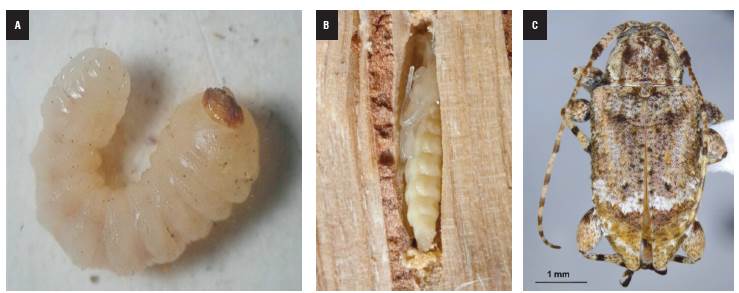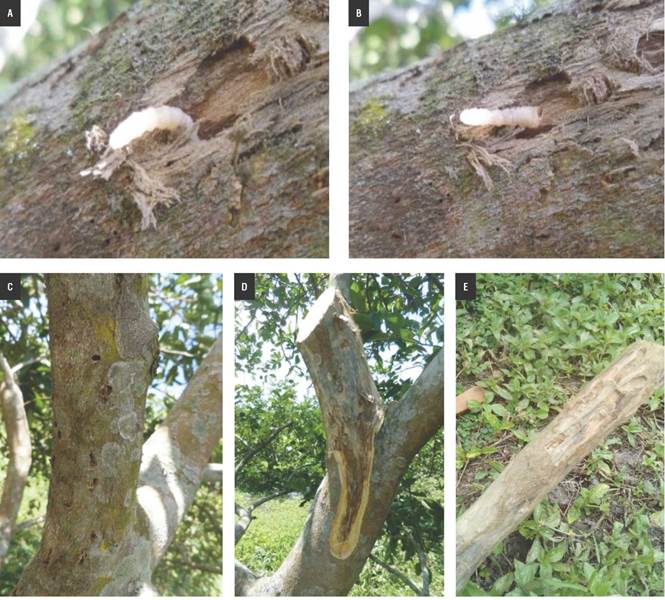Introduction
Citrus fruits are perennial and commonly have high adaptability to diverse climatic conditions. Some varieties of Citrus adapt well because Colombian geography has favorable characteristics for their growth and development (Orduz-Rodríguez and Mateus, 2012). In Colombia, 96,000 ha were reported with citrus crops in the year 2017 (MADR, 2017), and, according to the National Agricultural Survey (DANE, 2016), the area cultivated with Tahiti limes included 23,638 ha distributed in 26 provinces. The main producer and exporter provinces of Tahiti lime are Santander, Tolima and Valle del Cauca. For the year 2017, Tahiti lime exports included 12.56 thousand t, which represented about 4% of the exportable horticultural products (Asohofrucol, 2017). The Tahiti lime has constant production throughout the year and, like other fruit trees, has technification limitations resulting from poor planning and fertilization (Rodríguez et al., 2018). In addition, phytosanitary problems, especially insect emerging pests, are present in this crop. This is the case for the stem borer Leptostylus hilaris, which is being reported for the first time for Colombia and for the Tahiti lime.
Given constant production throughout the year and the population dynamics of insects, the phytosanitary management of production is complex. The presence of a new insect associated with the cultivation of citrus fruits makes it necessary and vital to elaborate and disseminate this record.
In a one ha Tahiti lime (Citrus latifolia (Rutaceae)) crop located at the Nataima research center in the municipality of Espinal, province of Tolima, the presence and damage caused by the insect L. hilaris were detected. To quantify the presence of larvae, pupae and adults of this insect and the damage (perforations) caused by the larvae in the trunks and branches of the trees (Fig. 1), samples were taken monthly during the period from July, 2016 to March, 2017. At the end of this period, 58 adult, 26 pupae and 60 larvae were collected. The insect samples were analyzed in the Entomology Laboratory of this center and stored in the "Luis María Murillo" Taxonomic Collection of Insects [Colección Taxonómica Nacional de Insectos Luis María Murillo] (CTNI), with the following information (Spanish in quotation marks):

FIGURE 1 Leptostylus hilaris individuals at different stages of development: a) larvae; b) pupae inside the stem; c) adult.
"COLOMBIA: Tolima: Espinal, Vda. San Francisco, C.I. Nataima, 410 m, 4°5' N, 74°56' O, ix-2016, B. Monje, Cap. Manual, "Taladrador de Citrus latifolia (Rutaceae) - Lima ácida Tahití". Three adult beetles and a pupa were deposited in the collection [CTNI 182] Det: J.P. Botero 2016.
The identification of the specimens was performed by consulting the original description and the photo of a holotype specimen. Additionally, specimens were compared with the ones in the collection of the Museu de Zoologia of the Universidade de São Paulo (São Paulo, Brazil).
In consecutive evaluations of Tahiti lime plants at the Nataima research center, it was demonstrated that the presence of L. hilaris is a new phytosanitary problem in the province of Tolima. This species is currently found in 60% of the crops. Populations of this stem borer are found inside stems and branches located in weak or dead organs. Sanitary pruning of branches and dead stems is a cultivation task that reduces the presence of this insect.
Several species of the Leptostylus genus are recorded as pests and are usually found on timber plantations with different feeding habits. Some examples are the xylophagy in Pinus oocarpa (Jiménez and Maes, 2005) or the spermophagy in L. gibbulosus on Manilkara zapota (Sapotaceae) and Sapindus saponaria (Sapindaceae) (Vogt, 1949; Arguedas, 2007; Romero et al., 2007; Hernández-Jaramillo et al., 2012), L. terraecolor on Rhizophora mangle (Rhizophoraceae) (Craighead, 1923), L. gundlachi in Erythrina glauca (Fa-baceae) (Wolcott, 1948), and L. spermovoratis in Dyospiros sp. fruits (Ebenaceae) (Chemsak, 1972).
Damage
Leptostylus hilaris larvae bore stems and branches that have previously been affected mechanically or by disease. Therefore, the presence of this insect in affected Tahiti lime plants is secondary. After completing its organ development, the larva makes a cell in the terminal part of a gallery that was previously perforated while feeding; the larva then prepares a chamber inside and closes the entrance of this chamber with a fiber plug cut from stem tissues; the larva then transforms into a pupa of a white or creamy color. After that, the adult emerges from the pupa, crawls through the galleries prepared when it was a larva, and perforates the tree bark until it reaches the exterior. It generates an elliptical contour hole whose diameter matches the thickness of the body (Fig. 2).

FIGURE 2 Leptostylus hilaris larvae (a, b) and the damage they cause in Tahiti lime trees (c, d, e). Photographs by Guzmán, 2016.
Morphological characteristics of the subfamily, tribe, genus and species of the stem borer Leptostylus hilaris are shown below.
Subfamily Lamiinae Latreille, 1825
It is the largest subfamily of Cerambycidae, extremely variable in form and size. It can be differentiated by the large and vertical frons and mouthparts oriented ventrally to posteroventrally; apical palpomere acuminated at the apex, and an anterior tibiae with a ventral obliquus sulcus.
Tribe Acanthocinini Blanchard, 1845
Eyes emarginated, finely granulated; antennae generally longer than the body; scape cylindrical and elongated; sides of prothorax with or without tubercles or spines; elytra long, and wider than the base of the prothorax; femora pedunculated; mesotibiae with sulcus; tarsal claws forked and simple.














